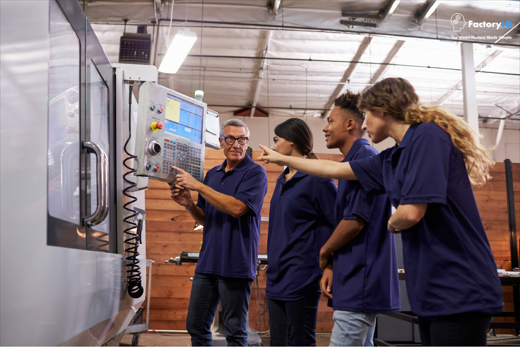Preparing for the Future: Upskilling the Manufacturing Workforce

The manufacturing industry is undergoing a rapid transformation, driven by advancements in automation, IoT, and data analytics. While these innovations improve efficiency and productivity, they also bring a critical challenge: ensuring the workforce is equipped with the necessary skills to operate, manage, and optimise these technologies.
The Need for Workforce Development
As digitalisation takes centre stage, traditional manufacturing roles are evolving. Operators, technicians, and managers now require expertise beyond mechanical knowledge—they need to understand data, automation, and real-time analytics. Without proper training, employees’ risk being left behind, leading to skill gaps that can hinder production and innovation.
According to a recent study, over 50% of manufacturing employees will require reskilling due to automation and AI integration. Businesses that invest in upskilling now will be better positioned to navigate these changes and remain competitive.
The Role of IoT and Data Analytics in Manufacturing
IoT-enabled smart factories generate vast amounts of data, offering insights into machine performance, energy usage, and production efficiency. However, these insights are only valuable if employees can interpret and act on them.
By training workers in data analytics and IoT systems, manufacturers can:
- Improve Decision-Making: Employees can proactively address inefficiencies and prevent downtime
- Enhance Productivity: Data-driven insights enable teams to optimize workflows and reduce waste
- Increase Equipment Effectiveness: Skilled employees can monitor and adjust machines in real time, boosting OEE (Overall Equipment Effectiveness)
Strategies for Upskilling the Workforce
-
Develop In-House Training Programmes
Companies can create tailored training sessions focusing on IoT fundamentals, data interpretation, and software tools specific to their industry -
Leverage Online Learning and Certifications
Many institutions offer courses on smart manufacturing, automation, and analytics. Encouraging employees to earn certifications enhances their knowledge and motivation -
Implement Hands-on Learning with Digital Tools
Providing employees with access to digital twins, IoT dashboards, and real-time analytics platforms allows them to develop practical skills in a controlled environment -
Simplify Technology Adoption
Choosing intuitive, user-friendly IoT solutions ensures employees can quickly learn and apply new tools without extensive training. Providing clear interfaces and guided onboarding makes the transition seamless -
Encourage Cross-Training and Knowledge Sharing
Instead of extensive retraining, businesses can foster adaptability by enabling employees to share expertise across teams. Cross-functional training helps bridge skill gaps and enhances collaboration
The Competitive Advantage of a Skilled Workforce
Investing in workforce development is not just about keeping up—it’s about gaining a competitive edge. A skilled workforce ensures higher efficiency, fewer errors, and greater adaptability to future technological changes. As manufacturing continues to evolve, companies that prioritise upskilling will lead the industry, drive innovation, and future-proof their operations.
By embracing workforce development today, manufacturers can equip their teams with the skills needed to maximise the benefits of smart factory solutions like FactoryIQ, ensuring efficiency and competitiveness now and in the future.